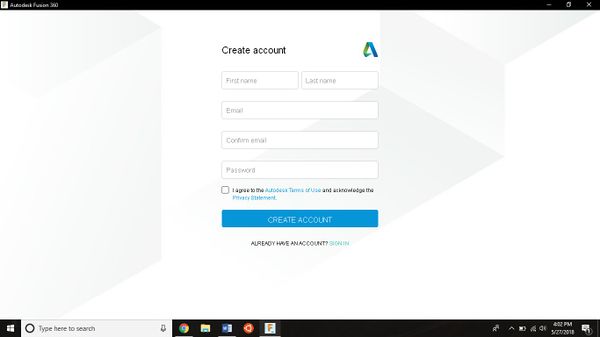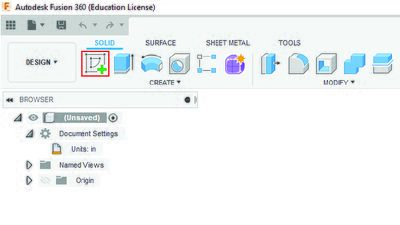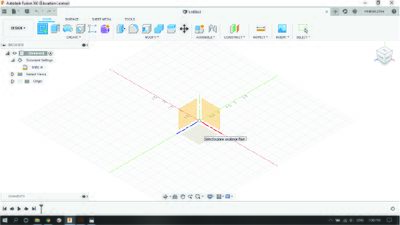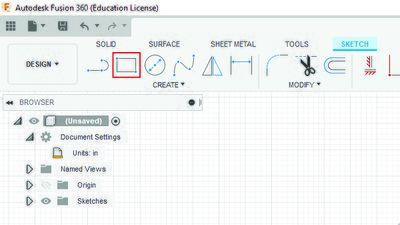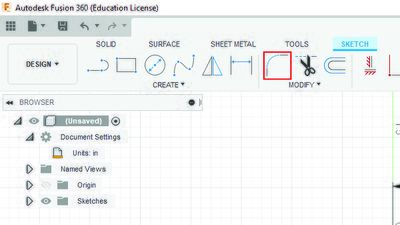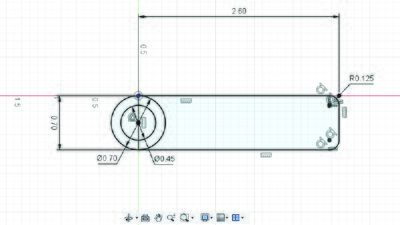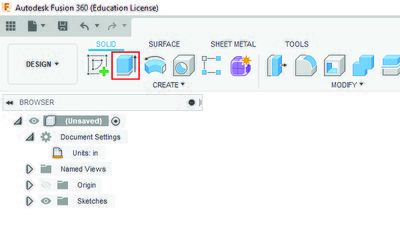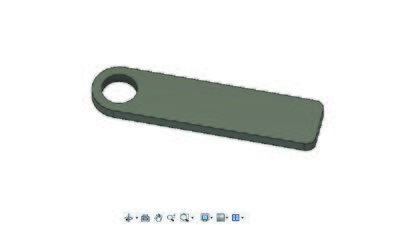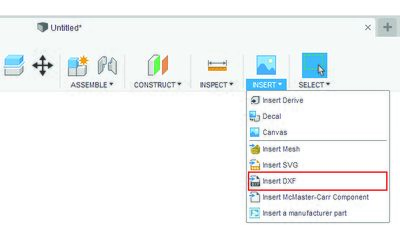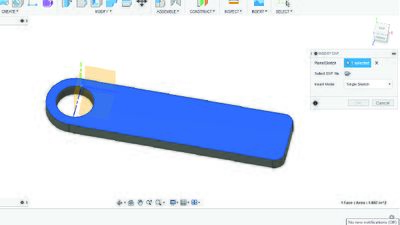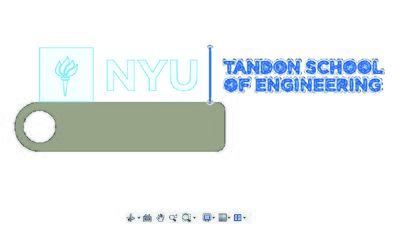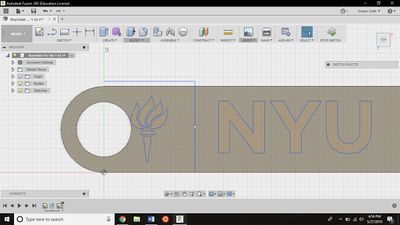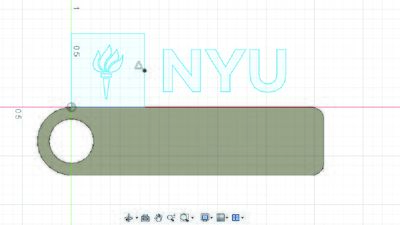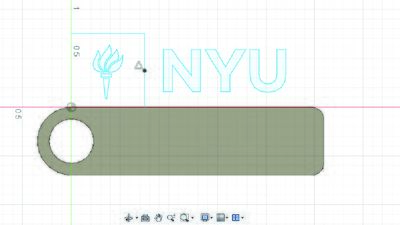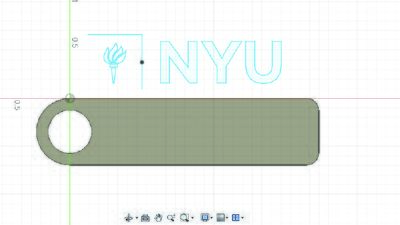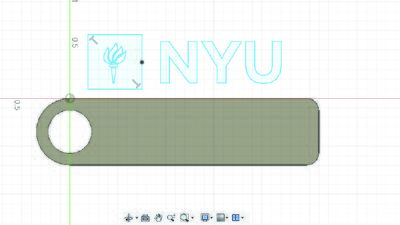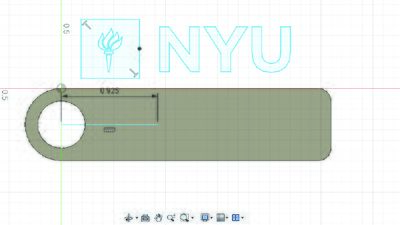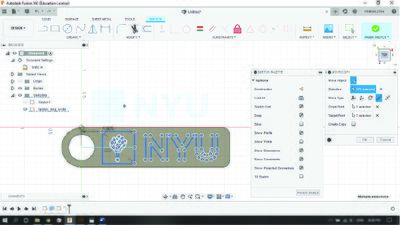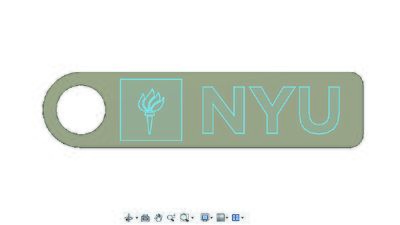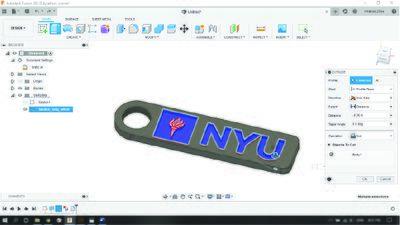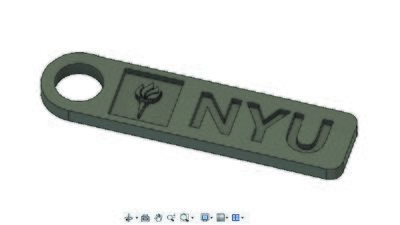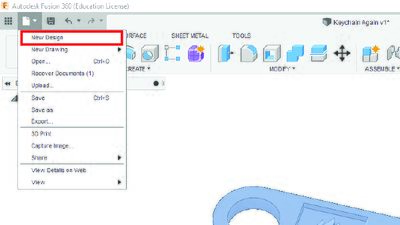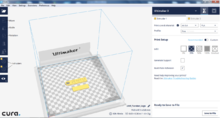Difference between revisions of "Introduction to 3D Printing Inventor"
m (changed all the "Inventor"s to "Fusion 360"s ugh) |
|||
| (58 intermediate revisions by 7 users not shown) | |||
| Line 1: | Line 1: | ||
= Objective = | = Objective = | ||
This exercise will introduce Autodesk Fusion 360, which is drafting software that is used by technical professionals, and basic technical design methods will be shown using this computer-aided design (CAD) software. This software will be used in your semester-long design project by constructing physical prototypes with 3D printing. | |||
To practice this prototyping procedure, | To practice this prototyping procedure, an NYU logo keychain will be created in Autodesk Fusion 360 and exported to be 3D printed. The members of the winning team of “Lab 1C: Mousetrap Vehicle Competition” will each receive a 3D-printed keychain. | ||
= Overview = | = Overview = | ||
== Computer-Aided Design == | == Computer-Aided Design == | ||
CAD programs | CAD programs, which include Fusion 360, AutoCAD, Revit, SolidWorks, and SketchUp, allow engineers to make precisely scaled drawings. These drawings are used to manufacture equipment, build infrastructure, and allow designers to display their designs with complete specifications and detail. Orthographic views (top, bottom, side, front, back, etc.) can be used to document every aspect of the technical drawing needed for production while isometric views can be used to view the final 3D representation of a product. | ||
This exercise will teach the basics of Autodesk | This exercise will teach the basics of Autodesk Fusion 360, 3D file formats, and the basics of 3D printing. After this lab, you will be able to create simple 3D files and set them up to be 3D printed. | ||
== 3D Printing == | == 3D Printing == | ||
3D printing allows for rapid prototyping and onsite manufacturing of products. | 3D printing allows for rapid prototyping and onsite manufacturing of products. Initially done with plastic, 3D printing now uses new techniques with new materials, such as aluminum, bronze, and glass. Biomaterials are also being incorporated, such as 3D printing ear cartilage and liver tissue. As the 3D printing industry grows, 3D printing will become a big part of many engineering fields. | ||
In this course, 3D printing can be used to produce SLDP course modifications, robot parts and a team logo for extra credit. | In this course, 3D printing can be used to produce SLDP course modifications, robot parts, and a team logo for extra credit. | ||
= Procedure = | = Procedure = | ||
== Setting up the file == | |||
# Start AutoDesk | # Start AutoDesk Fusion and create an account IMPORTANT: Make sure to use your NYU email.(Figure 1) | ||
#: [[Image:Lab 1B.jpg|thumb|center|600px|Figure 1: Fusion 360 new file options]] | |||
#: [[Image: | |||
== Designing the NYU Keychain == | |||
# The first step to designing the keychain is to draw the base shape | # The first step to designing the keychain is to draw the base shape: | ||
#:# | #:# Start 2D Sketch. (Figure 2)[[Image:Lab 1B2.jpg|thumb|center|400px|Figure 2: Sketch Mode]] | ||
#:# | #:# Select the XZ plane. (Figure 3)[[Image:Lab 1B3.jpg|thumb|center|400px|Figure 3: XZ Plane]] | ||
#:# Rotate the camera to orient the top correctly | #:# Rotate the camera to orient the top correctly using the arrows in the top right of the screen. | ||
#:# Select the rectangle tool | #:# Select the rectangle tool from the "Sketch" section of the toolbar. (Figure 4) [[Image:Lab 1B4.jpg|thumb|center|400px|Figure 4: Rocking Rectangle]] | ||
#:#:# Draw a 2.6” x 0.7” rectangle starting at the origin | #:#:# Draw a 2.6” x 0.7” rectangle starting at the origin. | ||
#:# | #:#:# These values can be typed in (switching which value is changed is done using the tab key) | ||
#:# | #:# Select the circle tool. | ||
#:#:# Draw a 0.7” diameter circle centered in the middle of one of the short sides of the rectangle (the cursor should snap to the center position and | #:#:# Draw a 0.7” diameter circle centered in the middle of one of the short sides of the rectangle (the cursor should snap to the center position and becomes blue X with a triangle when you get close.) (Figure 5) [[Image:Lab 1B5.jpg|thumb|center|400px|Figure 5: Cool Circle]] | ||
#:#:# Draw another circle 0.45” in diameter in the same position | #:#:# Draw another circle 0.45” in diameter in the same position, the sketch should look like Figure 6.[[Image:Lab 1B6.jpg|thumb|center|400px|Figure 6: Smaller Circle]] | ||
#:# Fillet (round) sharp edges | #:# Fillet (round) sharp edges. | ||
#:#:# Select the fillet tool from the | #:#:# Select the fillet tool from the “Sketch” section of the toolbar (do not use the one under "Modify"). (Figure 7)[[Image:Lab 1B7.jpg|thumb|center|400px|Figure 7: THE Fillet Tool]] | ||
#:#:# Select one of | #:#:# Select one of the two intersecting lines that form the right angles on the base. | ||
#:#:# Use the default fillet size of 0.125” and repeat on the other corner | #:#:# Use the default fillet size of 0.125” and repeat on the other corner. | ||
#:#:# The sketch should look like Figure 8.[[Image:Lab 1B8.jpg|thumb|center|400px|Figure 8: Fillet Everything]] | |||
#:# Remove the extra lines using the trim tool | #:# Remove the extra lines using the trim tool | ||
#:#:# Select the trim tool from the “Sketch” section of the toolbar (It is under the fillet tool). | |||
#:#:# Select the trim tool from the | #:#:# Select all interior lines that divide the keychain. | ||
#:#:# Select all interior lines that divide the keychain | #:#:# If error messages are indicated, remove the dimensions on the rest of the keychain. | ||
#:# Exit the sketch using the | #:#:# The sketch should look like Figure 9.[[Image:Lab 1B9.jpg|thumb|center|400px|Figure 9: Keychain base]] | ||
# After creating a 2D sketch the next step is to use that to create a 3D object. In this lab | #:# Exit the sketch using the "Stop Sketch" button. | ||
#:# Select the “Extrude” tool from the “Create” section of the toolbar | #After creating a 2D sketch, the next step is to use that to create a 3D object. In this lab the extrude tool will be used to create a 3D block. In the future, the revolve or other tools can be used to create more advanced geometry. | ||
#:#:# Select the profile of the object | #:# Select the “Extrude” tool from the “Create” section of the toolbar (Figure 10).[[Image:Lab 1B10.jpg|thumb|center|400px|Figure 10: Extrude Tool]] | ||
#:#:# Change the extrusion thickness to 0.15” and press Enter. | #:#:# Select the profile of the object to be extruded, which is the object that was just created. | ||
# The next step is to add | #:#:# Change the extrusion thickness to 0.15” and press Enter. | ||
#:# Download the NYU Tandon Vector Logo | #:#:# The model will look like Figure 11.[[Image:Lab 1B11.jpg|thumb|center|400px|Figure 11: #Deep]] | ||
# The next step is to add the design to the key chain. For this lab, a vector graphics file will be used in the dxf format provided by NYU. In the future, a logo can be designed using the sketch tool. | |||
#:# Download the NYU Tandon Vector Logo (This logo was converted from the file provided on NYU's identity page). | |||
#:#:# * [[Media:Tandon_long_white.zip|Tandon logo ACAD format]] | #:#:# * [[Media:Tandon_long_white.zip|Tandon logo ACAD format]] | ||
#:# | #:# Select “Insert DXF" under the "Insert" section of the toolbar. (Figure 12)[[Image:Lab 1B12.jpg|thumb|center|400px|Figure 12: Insert DXF]] | ||
#:# Select the top surface of the key chain (Figure 13).[[Image:Lab 1B13.jpg|thumb|center|400px|Figure 13: Top Surface Select]] | |||
#:# Select the top surface of the key chain | #:# Rotate the camera again to orient the top correctly. | ||
#:# Rotate the camera again to orient the top correctly | #:# Click on the file folder on the window that pops up and select .dxf file you downloaded. | ||
#:# | #:# The logo should appear. (Figure 14)[[Image:Lab 1B14.jpg|thumb|center|400px|Figure 14: Beautiful Logo]] | ||
#:# | #:#:# Make sure you change the units to inches. | ||
#:# For this side of the key chain the "Tandon School of Engineering" portion of the logo is not needed. | |||
#:#:# Select the bar and everything to the right using click and drag (Figure 15).[[Image:Lab 1B15.jpg|thumb|center|400px|Figure 15: RIP Tandon]] | |||
#:#:# Delete this portion with the “Delete” key on the keyboard (Not Backspace). | |||
#:# The logo needs to be scaled to fit the key chain. To keep the spacing of the design, select an appropriate base point. Use the midpoint of the line on the right side of the box. | |||
#:# For this side of the key chain the | #:#:# Select the point tool under the "Sketch" section of the toolbar. | ||
#:#:# Select the bar and everything to the right using click and drag | #:#:# Place a point at the center point of the right side of the box. | ||
#:#:# Delete this portion with the “Delete” key on the keyboard (Not Backspace) | #:#:# Delete the bottom and the left side of the box. (Figure 16)[[Image:Lab 1B16.jpg|thumb|center|400px|Figure 16: Partly Delete Box]] | ||
#:# | #:#:# Select the "Scale tool from the "Modify" section of the toolbar. | ||
#:#:# | #:#:# Select the box and torch of the logo by clicking and dragging. | ||
#:#:# | |||
#:#:# | |||
#:#:# Select the | |||
#:#:# Select the box and torch of the logo by clicking and dragging | |||
#:#:# Select the midpoint that was just placed as the base point for scaling | #:#:# Select the midpoint that was just placed as the base point for scaling | ||
#:#:# Enter a scaling factor of 0.75 | #:#:# Enter a scaling factor of 0.75. (Figure 17)[[Image:Lab 1B17.jpg|thumb|center|400px|Figure 17: Scale the Box]] | ||
#:# | #:#:# Redraw the 2 sides of the box we deleted using the line tool in the “Sketch” section of the toolbar. (Figure 18)[[Image:Lab 1B18.jpg|thumb|center|400px|Figure 18: Redraw Box]] | ||
#:#:# Select the entire logo and use the “Move” tool from the Modify section of the toolbar to move it off the base so there is space to draw the alignment line | #:# The logo will be positioned on the keychain. | ||
#:#:# Select the line tool and draw a 0. | #:#:# Select the entire logo and use the “Move” tool from the Modify section of the toolbar to move it off the base so there is space to draw the alignment line. [[Image:Lab 1B19.jpg|thumb|center|400px|Figure 19: Adjust the Logo]] | ||
#:#:#:[[Image: | #:#:# Select the line tool and draw a 0.925” line from the center of the circle towards the center of the keychain. | ||
#:#:# Select the | #:#:# Select the logo using the move tool again. | ||
#:#:# | #:#:# Select “Point to Point” as the move type in the window that appears. (Figure 20)[[Image:Lab 1B20.jpg|thumb|center|400px|Figure 20: Move the Logo]] | ||
#:#:# Exit the | #:#:# Select the midpoint from the side of the box and the end of the line you just created. | ||
#:# To finish this side of the keychain the design | #:#:#:# The logo should snap to it. (Figure 21)[[Image:Lab 1B21.jpg|thumb|center|400px|Figure 21: Snap the Logo]] | ||
#:#:# To cut the design select | #:#:# Delete the guideline you created. | ||
#:#:# Select the profile of the design to cut, in this case the area around the torch and each of the letters | #:#:# Exit the sketch. | ||
#:#:# Select a | #:#:# The final sketch is shown in Figure 22.[[Image:Lab 1B22.jpg|thumb|center|400px|Figure 22: Finally Final Sketch]] | ||
# To 3D print the design | #To finish this side of the keychain, the design must be cut into the base. To do this, the extrude tool will be used. | ||
#:# Click the | #:#:# To cut the design, select “Extrude" from the "Create" section of the toolbar. | ||
#:#:# Select the profile of the design to cut, in this case, the area around the torch and each of the letters. (Figure 23)[[Image:Lab 1B23.jpg|thumb|center|400px|Figure 23: Select the Outline]] | |||
#:#:# Select "Cut" from the drop down menu next to "Operation" in the window that appeared on the right. (Figure 24)[[Image:Lab 1B24.jpg|thumb|center|400px|Figure 24: Cut the Outline]] | |||
#:#:# Select a distance of -0.06". | |||
#: [[Image: | #:#:# The final model is shown in Figure 25.[[Image:Lab 1B25.jpg|thumb|center|400px|Figure 25: Depth to the Outline]] | ||
# The last step of the keychain is to make the white insert that will fit in the center to make it | # To 3D print the design, export the file as an STL. This is the only format that can be opened by the 3d printing software. | ||
#:# Click | #:# Click on triangle to the left "Document Settings" to expand the menu, and hover over "Units" to click on the "Change Active Units" button on the right to change to millimeters, but DO NOT set millimeters as the default (default units should be inches). This will convert the model into millimeters. Even though the models are built in inches, millimeters is the only unit that 3D printing software will recognize. | ||
#:# Start a | #:# Right click on the box above “Document Settings” and select “Save as STL”. (Figure 26)[[Image:Lab 1B26.jpg|thumb|center|400px|Figure 26: Save Your Work]] | ||
#:# Create a rectangle with dimensions 2.2”x0.65” | #:# Click "OK" no need to change any of the setting. | ||
#:# Extrude the rectangle 0.12” | #:# Make sure you save it to a location you'll remember like the desktop. | ||
#:# | # The last step of the keychain is to make the white insert that will fit in the center to make it two colors. | ||
#:# Click “File" in the toolbar at the top of the screen. | |||
#:# Start a "New Design". (Figure 27)[[Image:Lab 1B27.jpg|thumb|center|400px|Figure 27: New Design]] | |||
#:# Create a rectangle with dimensions 2.2”x0.65”. | |||
#:# Extrude the rectangle 0.12”. | |||
#:#:# This model is shown in Figure 28.[[Image:Lab 1B28.jpg|thumb|center|400px|Figure 28: Inside Box]] | |||
#:# Save this the same way as before. | |||
== Preparing to print == | |||
# Now that the logo design is complete, the next step is to put it together in the 3D printing slicer software. We will be using Cura as the software for orienting parts on the printer and selecting the color of each object. It also generates toolpaths that the printer will follow to print the objects. | |||
#:# Open Cura. If a menu pops up prompting for the printer, select the “Ultimaker 3” | |||
#:#:# If a menu does not pop up, make sure the printer currently selected is “Ultimaker 3” on the top right corner | |||
#:#:# Otherwise, click the arrow, select the “Add Printer” option, and add “Ultimaker 3.” | |||
#:# To load your two files from above, select “Open File” on the top left corner and open the STL file containing the base of the keychain | |||
#:# Using the “Rotate” tool on among the options to the left, rotate the part so the torch is facing up | |||
#:#:# Uncheck the “Snap Scaling” option to allow for a more precise rotation | |||
#:# Select “Open File” again and load the filler rectangle | |||
#:# Again, orient the part correctly using the “Rotate” tool | |||
#:# Cura, by default, drops the objects on to the build-plate and keeps objects apart. The following steps are needed to combine the filler rectangle within the keychain: | |||
#:#:# Under “Preferences”, select “Configure Cura” | |||
#:#:# Under “Viewport behavior,” make sure to deselect both “Ensure models are kept apart” and “Automatically drop models to the build plate” if they are not already deselected | |||
#:#:# Save your preferences | |||
#:#:# Return to the buildplate and make sure both objects are lying flat on the build-plate by using “Rotate” => “Lay Flat” | |||
#:#:#:# If the “Lay Flat” tool does not lay the object flat, manually type in 0 mm in the “Move” tool for the Z axis | |||
#:# Select the filler rectangle, and using the “Move” tool on the left, enter 0.15mm as the Z value to raise it vertically | |||
#:# Select one object and choose a different extruder on the left. That piece will appear as a different color | |||
#:# Drag the filler piece and place it in the keychain base part | |||
#:# Save the file as a .gcode and upload it to the website | |||
[[Image:Cura_1.png|thumb|right|220px|Figure 29: Cura with both parts loaded]] | |||
[[Image:Cura_2.png|thumb|right|220px|Figure 30: Cura with the base and the infill of the logo]] | |||
= Assignment = | |||
A *.'''gcode''' file must be [https://eg.poly.edu/submit.php submitted to eg.poly.edu]. It is required for a lab report grade. | |||
[ | |||
{{Laboratory Experiments}} | {{Laboratory Experiments}} | ||
Latest revision as of 22:12, 29 January 2019
Objective
This exercise will introduce Autodesk Fusion 360, which is drafting software that is used by technical professionals, and basic technical design methods will be shown using this computer-aided design (CAD) software. This software will be used in your semester-long design project by constructing physical prototypes with 3D printing.
To practice this prototyping procedure, an NYU logo keychain will be created in Autodesk Fusion 360 and exported to be 3D printed. The members of the winning team of “Lab 1C: Mousetrap Vehicle Competition” will each receive a 3D-printed keychain.
Overview
Computer-Aided Design
CAD programs, which include Fusion 360, AutoCAD, Revit, SolidWorks, and SketchUp, allow engineers to make precisely scaled drawings. These drawings are used to manufacture equipment, build infrastructure, and allow designers to display their designs with complete specifications and detail. Orthographic views (top, bottom, side, front, back, etc.) can be used to document every aspect of the technical drawing needed for production while isometric views can be used to view the final 3D representation of a product.
This exercise will teach the basics of Autodesk Fusion 360, 3D file formats, and the basics of 3D printing. After this lab, you will be able to create simple 3D files and set them up to be 3D printed.
3D Printing
3D printing allows for rapid prototyping and onsite manufacturing of products. Initially done with plastic, 3D printing now uses new techniques with new materials, such as aluminum, bronze, and glass. Biomaterials are also being incorporated, such as 3D printing ear cartilage and liver tissue. As the 3D printing industry grows, 3D printing will become a big part of many engineering fields.
In this course, 3D printing can be used to produce SLDP course modifications, robot parts, and a team logo for extra credit.
Procedure
Setting up the file
- Start AutoDesk Fusion and create an account IMPORTANT: Make sure to use your NYU email.(Figure 1)
Designing the NYU Keychain
- The first step to designing the keychain is to draw the base shape:
- Start 2D Sketch. (Figure 2)
- Select the XZ plane. (Figure 3)
- Rotate the camera to orient the top correctly using the arrows in the top right of the screen.
- Select the rectangle tool from the "Sketch" section of the toolbar. (Figure 4)
- Draw a 2.6” x 0.7” rectangle starting at the origin.
- These values can be typed in (switching which value is changed is done using the tab key)
- Select the circle tool.
- Draw a 0.7” diameter circle centered in the middle of one of the short sides of the rectangle (the cursor should snap to the center position and becomes blue X with a triangle when you get close.) (Figure 5)
- Draw another circle 0.45” in diameter in the same position, the sketch should look like Figure 6.
- Fillet (round) sharp edges.
- Select the fillet tool from the “Sketch” section of the toolbar (do not use the one under "Modify"). (Figure 7)
- Select one of the two intersecting lines that form the right angles on the base.
- Use the default fillet size of 0.125” and repeat on the other corner.
- The sketch should look like Figure 8.
- Remove the extra lines using the trim tool
- Select the trim tool from the “Sketch” section of the toolbar (It is under the fillet tool).
- Select all interior lines that divide the keychain.
- If error messages are indicated, remove the dimensions on the rest of the keychain.
- The sketch should look like Figure 9.
- Exit the sketch using the "Stop Sketch" button.
- After creating a 2D sketch, the next step is to use that to create a 3D object. In this lab the extrude tool will be used to create a 3D block. In the future, the revolve or other tools can be used to create more advanced geometry.
- Select the “Extrude” tool from the “Create” section of the toolbar (Figure 10).
- Select the profile of the object to be extruded, which is the object that was just created.
- Change the extrusion thickness to 0.15” and press Enter.
- The model will look like Figure 11.
- Select the “Extrude” tool from the “Create” section of the toolbar (Figure 10).
- The next step is to add the design to the key chain. For this lab, a vector graphics file will be used in the dxf format provided by NYU. In the future, a logo can be designed using the sketch tool.
- Download the NYU Tandon Vector Logo (This logo was converted from the file provided on NYU's identity page).
- Select “Insert DXF" under the "Insert" section of the toolbar. (Figure 12)
- Select the top surface of the key chain (Figure 13).
- Rotate the camera again to orient the top correctly.
- Click on the file folder on the window that pops up and select .dxf file you downloaded.
- The logo should appear. (Figure 14)
- Make sure you change the units to inches.
- For this side of the key chain the "Tandon School of Engineering" portion of the logo is not needed.
- Select the bar and everything to the right using click and drag (Figure 15).
- Delete this portion with the “Delete” key on the keyboard (Not Backspace).
- The logo needs to be scaled to fit the key chain. To keep the spacing of the design, select an appropriate base point. Use the midpoint of the line on the right side of the box.
- Select the point tool under the "Sketch" section of the toolbar.
- Place a point at the center point of the right side of the box.
- Delete the bottom and the left side of the box. (Figure 16)
- Select the "Scale tool from the "Modify" section of the toolbar.
- Select the box and torch of the logo by clicking and dragging.
- Select the midpoint that was just placed as the base point for scaling
- Enter a scaling factor of 0.75. (Figure 17)
- Redraw the 2 sides of the box we deleted using the line tool in the “Sketch” section of the toolbar. (Figure 18)
- The logo will be positioned on the keychain.
- Select the entire logo and use the “Move” tool from the Modify section of the toolbar to move it off the base so there is space to draw the alignment line.
- Select the line tool and draw a 0.925” line from the center of the circle towards the center of the keychain.
- Select the logo using the move tool again.
- Select “Point to Point” as the move type in the window that appears. (Figure 20)
- Select the midpoint from the side of the box and the end of the line you just created.
- The logo should snap to it. (Figure 21)
- Delete the guideline you created.
- Exit the sketch.
- The final sketch is shown in Figure 22.
- To finish this side of the keychain, the design must be cut into the base. To do this, the extrude tool will be used.
- To cut the design, select “Extrude" from the "Create" section of the toolbar.
- Select the profile of the design to cut, in this case, the area around the torch and each of the letters. (Figure 23)
- Select "Cut" from the drop down menu next to "Operation" in the window that appeared on the right. (Figure 24)
- Select a distance of -0.06".
- The final model is shown in Figure 25.
- To 3D print the design, export the file as an STL. This is the only format that can be opened by the 3d printing software.
- Click on triangle to the left "Document Settings" to expand the menu, and hover over "Units" to click on the "Change Active Units" button on the right to change to millimeters, but DO NOT set millimeters as the default (default units should be inches). This will convert the model into millimeters. Even though the models are built in inches, millimeters is the only unit that 3D printing software will recognize.
- Right click on the box above “Document Settings” and select “Save as STL”. (Figure 26)
- Click "OK" no need to change any of the setting.
- Make sure you save it to a location you'll remember like the desktop.
- The last step of the keychain is to make the white insert that will fit in the center to make it two colors.
- Click “File" in the toolbar at the top of the screen.
- Start a "New Design". (Figure 27)
- Create a rectangle with dimensions 2.2”x0.65”.
- Extrude the rectangle 0.12”.
- This model is shown in Figure 28.
- Save this the same way as before.
Preparing to print
- Now that the logo design is complete, the next step is to put it together in the 3D printing slicer software. We will be using Cura as the software for orienting parts on the printer and selecting the color of each object. It also generates toolpaths that the printer will follow to print the objects.
- Open Cura. If a menu pops up prompting for the printer, select the “Ultimaker 3”
- If a menu does not pop up, make sure the printer currently selected is “Ultimaker 3” on the top right corner
- Otherwise, click the arrow, select the “Add Printer” option, and add “Ultimaker 3.”
- To load your two files from above, select “Open File” on the top left corner and open the STL file containing the base of the keychain
- Using the “Rotate” tool on among the options to the left, rotate the part so the torch is facing up
- Uncheck the “Snap Scaling” option to allow for a more precise rotation
- Select “Open File” again and load the filler rectangle
- Again, orient the part correctly using the “Rotate” tool
- Cura, by default, drops the objects on to the build-plate and keeps objects apart. The following steps are needed to combine the filler rectangle within the keychain:
- Under “Preferences”, select “Configure Cura”
- Under “Viewport behavior,” make sure to deselect both “Ensure models are kept apart” and “Automatically drop models to the build plate” if they are not already deselected
- Save your preferences
- Return to the buildplate and make sure both objects are lying flat on the build-plate by using “Rotate” => “Lay Flat”
- If the “Lay Flat” tool does not lay the object flat, manually type in 0 mm in the “Move” tool for the Z axis
- Select the filler rectangle, and using the “Move” tool on the left, enter 0.15mm as the Z value to raise it vertically
- Select one object and choose a different extruder on the left. That piece will appear as a different color
- Drag the filler piece and place it in the keychain base part
- Save the file as a .gcode and upload it to the website
- Open Cura. If a menu pops up prompting for the printer, select the “Ultimaker 3”
Assignment
A *.gcode file must be submitted to eg.poly.edu. It is required for a lab report grade.
| ||||||||
